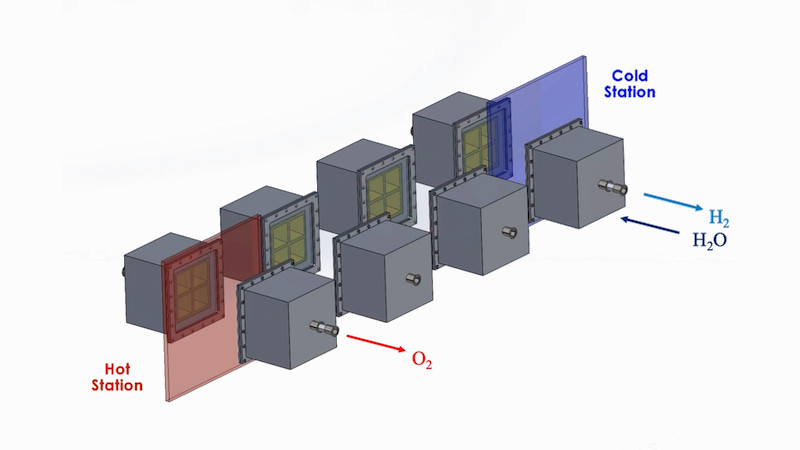Smart #1 in the test: Successful new edition of an icon
When the name Smart is mentioned, everyone automatically thinks of the two-seater Fortwo, which has meanwhile enjoyed cult status. Mercedes-Benz was already working on the idea of a compact city car in the 1980s, founded the Smart company in 1994 and launched the Fortwo in 1998. At that time, the colourful, rear-wheel drive microcar, which was still called a city coupé until 2004 and which could fit into any parking space, was a real eye-catcher on Germany’s streets. This was followed by a convertible variant, the four-seater Forfour and the Smart Roadster.
All these models enjoyed great popularity among fans of the brand. But what many people don’t know is that Smart was never a success for Mercedes-Benz. On the contrary. Der Spiegel even described the small car as the “biggest flop in recent company history”, through which the group lost several hundred million euros.
And that’s exactly what shouldn’t happen with the new Smart #1. For this reason, the brand has reinvented itself for the all-electric age. The high standards of design and quality have remained, but in keeping with the spirit of the times, what was once a small car has become a compact SUV that is suitable for everyday use and even for families.
Despite its compact dimensions, the Smart #1 offers space for up to five people. (Photo: Sascha Gloede)
Contents
Smart #1: A compact electric car that leaves nothing to be desired
With a length of 4.27 meters and a width of 1.82 meters, the new Smart #1 is about the same size as a VW ID 3. The frunk, i.e. the front trunk, holds 15 liters and the rear trunk 323 liters. However, the rear seat bench is not only foldable, but can also be moved. In this way, the trunk volume can be increased if necessary, which, in combination with the divisible rear bench seat (60:40), ensures maximum flexibility while at the same time making optimal use of the available space.
The Smart #1 (from 42,490 euros) comes with rear-wheel drive and 200 kilowatts (272 hp) as standard. It goes from 0 to 100 km/h in 6.7 seconds. The 66-kilowatt-hour battery enables a range of 440 kilometers in the WLTP cycle. Anyone who likes to be sporty can go for the Smart #1 Brabus (from 48,990 euros). The two-motor all-wheel drive with 315 kilowatts (428 hp) catapults the all-electric compact SUV from 0 to 100 km/h in 3.9 seconds. For comparison: Even a Porsche Taycan 4S needs four seconds for this. However, this enormous performance has to be paid for with the range, which drops to 400 kilometers (WLTP).
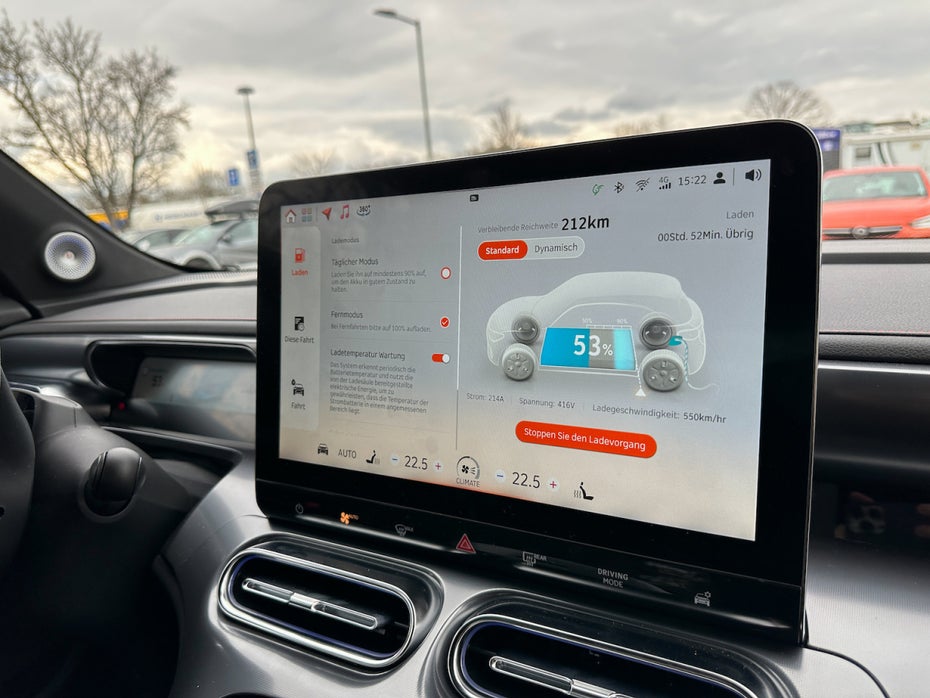
Depending on driving style and engine, the Smart #1 can cover between 350 and 400 kilometers. (Photo: Sascha Gloede)
What makes the Smart #1 so interesting as an electric car is the charging capacity. If you are traveling long distances, 150 kilowatts of direct current (DC) are available on the fast charger. The charging process from 10 to 80 percent SoC (state of charge) takes less than 30 minutes. However, what is even more important for an electric car that was primarily designed for the city: AC charging stations can charge with up to 22 kilowatts. The times when the car had to stand at the charging station for five or six hours until the battery was charged are over.
The Smart #1 is also not stingy with other equipment: Adaptive LED headlights, gesture-controlled tailgate, panoramic roof, ambient lighting with 64 colors and 20 lighting levels, 10-inch head-up display, heat pump, automatic parking assistant, 360-degree surround Camera, Beats sound system and of course all common driver assistance systems are on board.
The first thing that strikes us when we get behind the wheel of the Smart #1 is the enormous amount of space available for a vehicle of this size. The compact SUV is a real miracle of space, especially when it comes to headroom and legroom. Two adults can even sit comfortably on the back seat.
Smart has also cleverly solved the trunk: at 323 liters, it is not huge, but if you need more space when shopping, for example, you simply push the rear seat forward, increasing the volume to 411 liters. This roughly corresponds to the trunk volume of the Volvo XC40 Recharge Pure Electric, which is a good 20 centimeters longer. By the way: The classic Smart Fortwo only managed 260 liters.
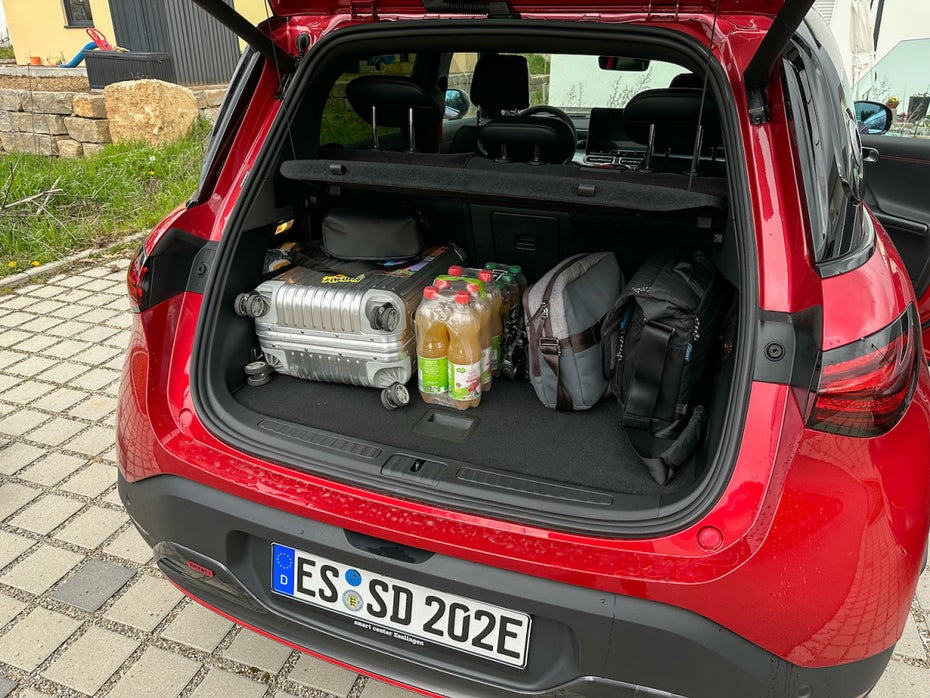
With the sliding rear seat bench, the trunk of the Smart #1 can be expanded to over 400 liters. (Photo: Sascha Gloede)
The interior of the Smart #1 looks very high-quality, everything is dominated by the 12.8-inch touchscreen display, which is ultimately the heart of the vehicle. The narrow 9.2-inch instrument cluster behind the steering wheel, meanwhile, takes some getting used to at first, but ultimately displays all the information you need. Especially since the view usually falls on the generous head-up display anyway.
And how does it drive? For our five-day test, we had the Smart #1 Brabus at our disposal, which, with its sports suspension, focuses primarily on dynamic rides. Because 428 hp and 543 Newton meters of torque must of course also be put on the road. As soon as you switch to Brabus mode, it becomes immediately clear how much power is in the compact SUV. The acceleration in particular is impressive. Nevertheless, one must be aware that the Smart #1 was ultimately not designed as a sports car, which is particularly noticeable on winding country roads.
If you don’t necessarily want to accelerate to 100 km/h in 3.9 seconds at every traffic light, you can drive cheaper and more comfortably in everyday life with the Smart #1 Pro+ or Premium. Especially since 6.7 seconds from 0 to 100 km/h are nothing to sneeze at.
Above all, you keep going with it. In our test, which included a trip to Italy, among other things, the average power consumption of the Smart #1 Brabus was around 20 kilowatt hours per 100 kilometers. This results in an everyday range of around 330 kilometers. With summer temperatures and a cautious driving style, 380 kilometers should also be feasible. This is a good value, but does not make the performance version a miracle of range. Those who value range are therefore better off with the Pro+ or the Premium, with which 400 kilometers and more are quite feasible.
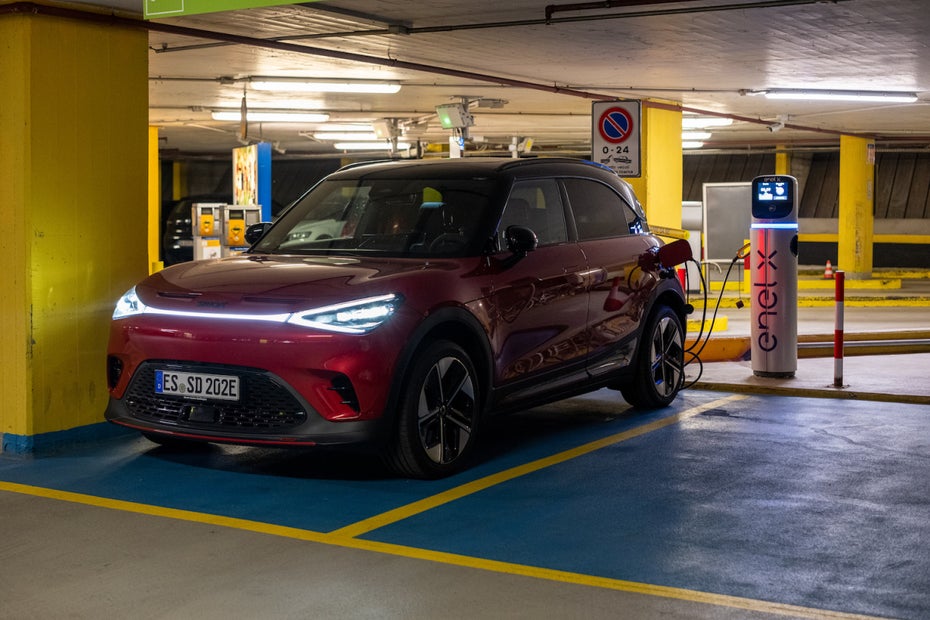
The Smart #1 manages 22 kilowatts at AC charging stations. (Photo: Sascha Gloede)
As far as charging is concerned, the Smart #1 scores particularly well in urban areas – where fast chargers are rare – with its 22 kilowatts. On our trip through Italy, we simply parked the compact SUV at one of the numerous AC charging stations while we were having breakfast in the café. After an hour, we already had 33 percent more in the battery. If you take your time, you can easily charge the Smart #1 to 80 percent. This is a huge advantage, especially for those who therefore have no charging facility at home and are dependent on the public charging infrastructure.
In our test, the Smart #1 managed the promised 150 kilowatts with the fast chargers along the freeways when the battery was almost empty, but from an SoC of 60 percent it was only around 80 kilowatts. The targeted loading time of less than 30 minutes from 10 to 80 percent SoC is feasible, but there is still a need for optimization.
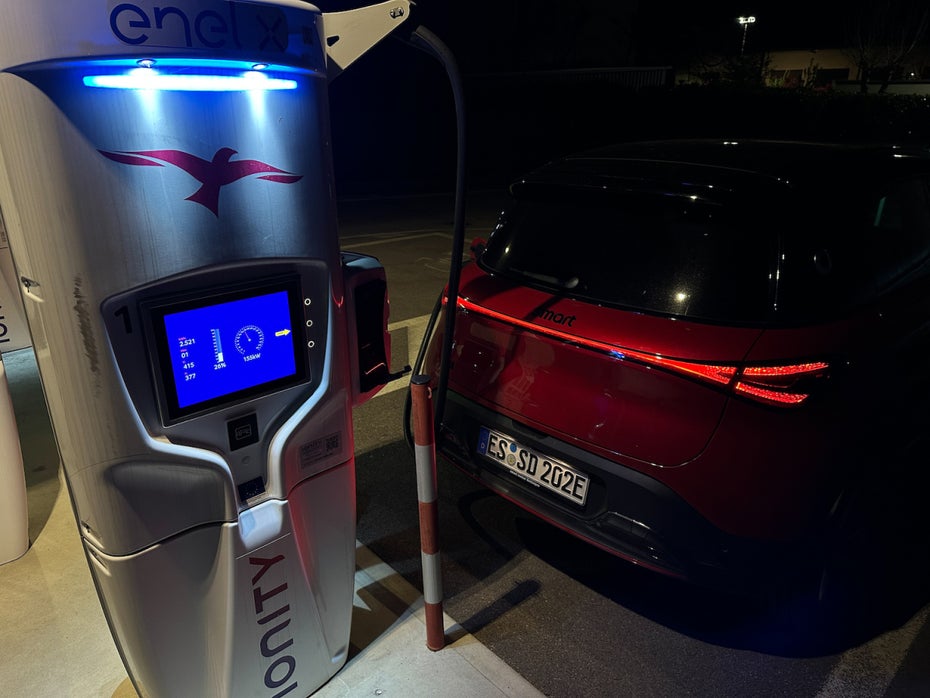
The fast charger has up to 155 kilowatts, but the charging curve of the Smart #1 can still be expanded. (Photo: Sascha Gloede)
Speaking of the need for optimization: Probably the biggest problem with the Smart #1 is currently the software.
The developers have gone to great lengths to create a user interface that matches the vehicle’s design requirements. In principle, they have succeeded. The playful user interface is intuitive and the fox as a virtual assistant gives the whole thing a playful touch. You have an infinite number of setting options and even a dog mode, which you won’t find even on the Mercedes-Benz EQS, which is two to three times as expensive, has been implemented. Everything seems well thought out and coherent.
Unfortunately, the current version of the software still has a few quirks. For example, the navigation system wanted to send us to a 22-kilowatt charging station after 280 kilometers on a long-distance journey instead of a fast charger. This must not happen, because reliable charging planning is essential, especially in times when many people are still skeptical about the topic of electromobility.
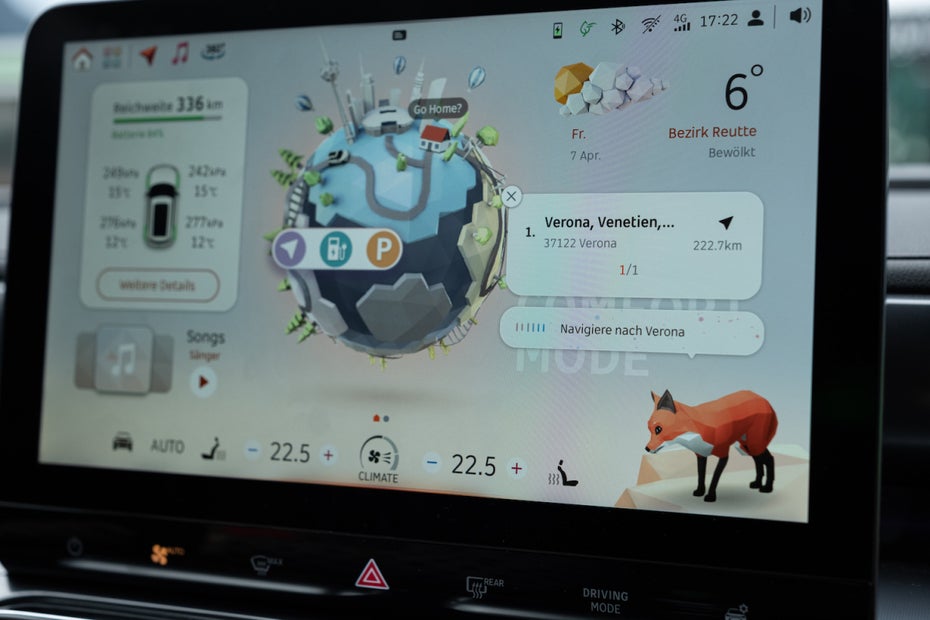
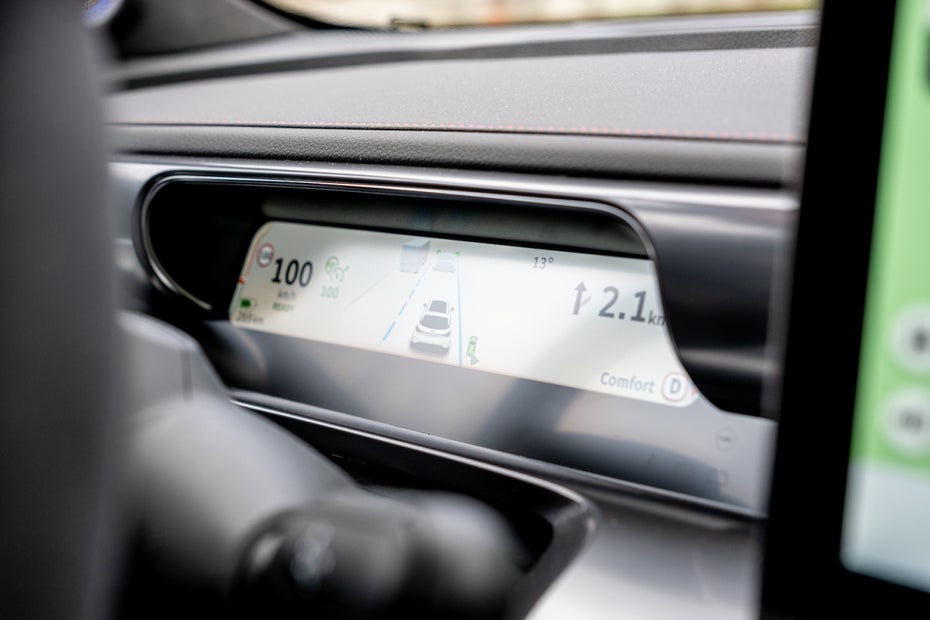

Visually, the software fits perfectly with the design-loving Smart #1 and offers all sorts of functions that you would look for in vain even in high-end vehicles. However, there are still some bugs that need to be fixed before the market launch. (Photo: Sascha Gloede)
The driver assistance systems are also still expandable. So the Smart #1 suddenly recognized 40 km/h on our drive on the Autobahn and started to slow down from 130 km/h. The adaptive high beam is also very “nervous”, which can quickly become irritating when driving at night.
All of these things can easily be fixed with an over-the-air software update – and Smart is aware of it, too. But the update should come quickly, because the first vehicles are already being delivered, and anyone who spends between 42,000 and 48,000 euros on the Smart #1 also has corresponding expectations.
The Smart #1 is definitely one of the most exciting and promising electric cars to come onto the market this year. Although it is quite compact, the #1 offers an incredible amount of space thanks to its well thought-out interior, which makes it the perfect everyday companion, even for families. It’s just not a pure city car for singles like the Fortwo was – and that’s a good thing.

It doesn’t matter where you take the Smart #1: the playful design is a real eye-catcher. (Photo: Sascha Gloede)
With a range of 350 to 400 kilometers and 22 kilowatts of AC or 150 kilowatts of DC charging power, the Smart #1 is just as at home in urban areas as it is on long journeys. As far as the equipment is concerned, the compact SUV is in no way inferior to most luxury vehicles, be it in terms of the head-up display, the Beats sound system, the spacious panoramic roof or the countless assistance systems.
If Smart manages to get the software problems under control in the short term, the Smart #1 should become a real bestseller – not least because of the comparatively favorable leasing conditions. In any case, the first production batch was sold out within a few hours at the start of sales.

